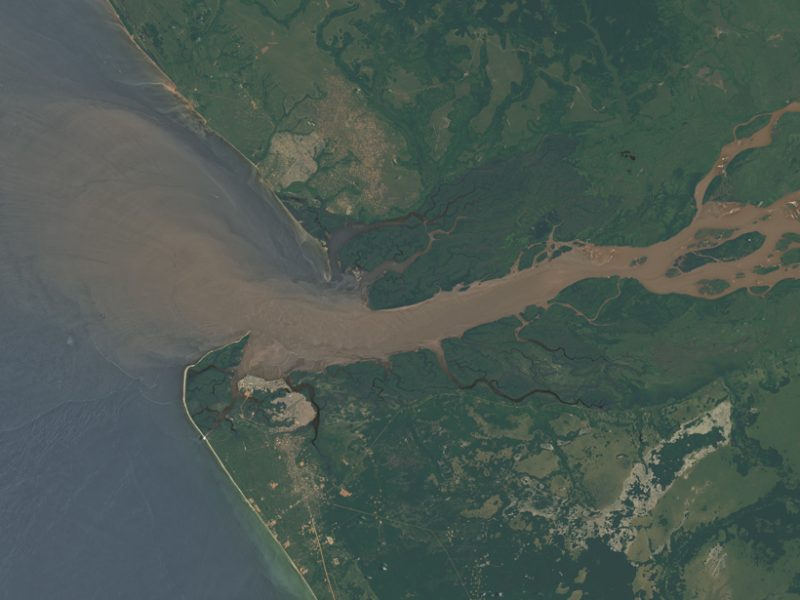
story by Helen Hill for MITGCM

A group from Japan has been using MITgcm to explore the spreading of river plumes.
Atsuhiko Isobe leads the Ocean Dynamics Group in the Center for Oceanic and Atmospheric Research in the Applied Mechanics Research Institute at Kyushu University in Japan. Particular interests include ocean circulation in coastal waters, air-sea interaction in marginal seas, and global marine plastic pollution. Nutrients, sediments, and pollutants that may be present in river outflow can impact both coastal ecosystems and the ocean circulation making river plume behavior an important topic in coastal oceanography.
Together with graduate student Yuichi Iwanaka, Isobe has been using MITgcm to simulate spreading of freshwater river plumes. Informed by field surveys conducted near the mouth of the Hiji River in Southern Japan, Iwanaka and Isobe performed numerical model experiments to investigate how fine structures generated in a tidally influenced river plume might affect plume behavior.
In the Northern Hemisphere discharged river water turns to the right from the viewpoint of an observer at a river mouth looking seaward to form a coastal boundary current flowing away from its source in the sense of a Kelvin wave. To map the Hiji river estuarian front, the team used conductivity-temperature-depth casts, combined with aerial photography of accumulated foam and debris captured from a ship-towed balloon equipped with a digital camera.
Their survey suggested the river plume had a thickness of <5 m which undulated on horizontal length scales of < 100m due to the development of small eddies along its course.
Turning to a nonhydrostatic implementation of the MITgcm the pair then set about reproducing the observed behavior and exploring sensitivity to tidal forcing.
They found that in experiments without tidal currents, the simulated river plume underwent unconstrained expansion to form something of a balloon offshore, while tidally forced plumes were confined near the river mouth.
Exploring further the team showed that their tidal plumes were dynamically equilibrated between the pressure gradient term and the advection term, with the advection term being composed mainly of contributions from the fine-scale disturbances, which act as friction because of the momentum exchange between the plume and ambient saline water.
Analysis of their model results indicated the horizontal and vertical components of the disturbances were generated by inertial and Kelvin-Helmholtz instability processes, respectively, leading the authors to propose that it is a combination of the river plume and tidal currents that likely enhances the current shear favorable for such instabilities to occur.
To find out more about this work contact Atsuhikoi.
This Month’s Featured Publication
- Yuichi Iwanaka and Atsuhiko Isobe (2018), Tidally Induced Instability Processes Suppressing River Plume Spread in a Nonrotating and Nonhydrostatic Regime, Journal of Geophysical Research Oceans, doi: 10.1029/2017JC013495
Other New Publications this Month
William Barham, Scott Bachman, Ian Grooms (2018), Some effects of horizontal discretization on linear baroclinic and symmetric instabilities, Ocean Modeling, Volume 125, May 2018, Pages 106-116, doi: 10.1016/j.ocemod.2018.03.004
Gregory F. de Souza, Samar P. Khatiwala, Mathis P. Hain, Susan H. Little, Derek Vance (2018), On the Origin of the Marine Zinc-Silicon Correlation, Earth and Planetary Science Letters, doi: 10.1016/j.epsl.2018.03.050
M.S. Filmer, C.W. Hughes, P.L. Woodworth, W.E. Featherstone, R.J. Bingham (2018), Comparison between geodetic and oceanographic approaches to estimate mean dynamic topography for vertical datum unification: evaluation at Australian tide gauges, Journal of Geodesy, doi: 10.1007/s00190-018-1131-5
Fukumori, I., P. Heimbach, R. Ponte, and C. Wunsch (2018), A Dynamically Consistent, Multi-Variable Ocean Climatology, Bull. Amer. Meteor. Soc, doi: 10.1175/BAMS-D-17-0213.1
D.N. Goldberg, K. Snow, P. Holland, J.R. Jordan, J.-M. Campin, P. Heimbach, R. Arthern, A. Jenkins (2018), Representing grounding line migration in synchronous coupling between a marine ice sheet model and a z-coordinate ocean model, Ocean Modelling, Volume 125, May 2018, Pages 45-60, doi: 10.1016/j.ocemod.2018.03.005
Malte F. Jansen, Louis-Philippe Nadeau, Timothy M. Merlis (2018), Transient versus Equilibrium Response of the Ocean’s Overturning Circulation to Warming, Journal of Climate, doi: 10.1175/JCLI-D-17-0797.1
Alexander G. Kalmikov and Patrick Heimbach (2018), On Barotropic Mechanisms of Uncertainty Propagation in Estimation of Drake Passage Transport, Monthly Weather Review, arXiv:1804.06033 [physics.ao-ph],
Anurag Kumar, Suneet Dwivedi, Avinash C.Pandey (2018), Quantifying predictability of sea ice around the Indian Antarctic stations using coupled ocean sea ice model with shelf ice, Polar Science, doi: 10.1016/j.polar.2018.04.003
Jessica Masich, Matthew R. Mazloff, Teresa K. Chereskin (2018), Interfacial Form Stress in the Southern Ocean State Estimate, Journal of Geophysical Research Oceans, doi: 10.1029/2018JC013844
Massimiliano Palma (2018), Toward a Coastal Processing Resolving Ocean Model-Nesting LES-COAST and MITgcm, Doctoral Dissertation, University of Triest, Italy
R.M. Ponte and C.G. Piecuch (2018), Mechanisms Controlling Global Mean Sea Surface Temperature Determined From a State Estimate, Geophysical Research Letters, doi: 10.1002/2017GL076821
Xi Zhang and Adam Showman (2018), Global-Mean Vertical Tracer Mixing in Planetary Atmospheres, arXiv:1803.09149 [astro-ph.EP]
Do you have news about research using MITgcm? We are looking for contributions to these pages. If you have an interesting MITgcm project (ocean, atmosphere, sea-ice, physics, biology or otherwise) that you want to tell people about, get in touch. To make a post, contact Helen
